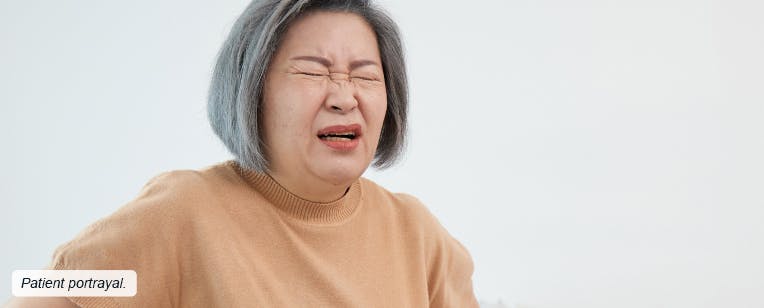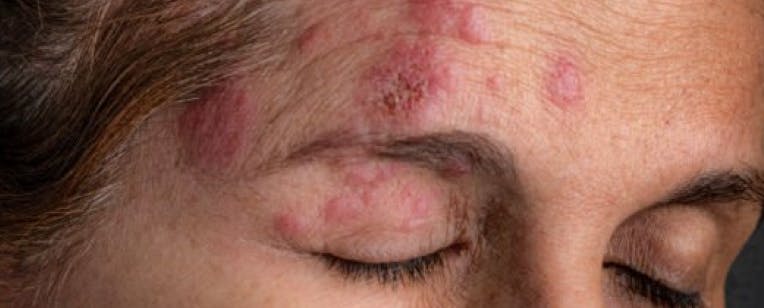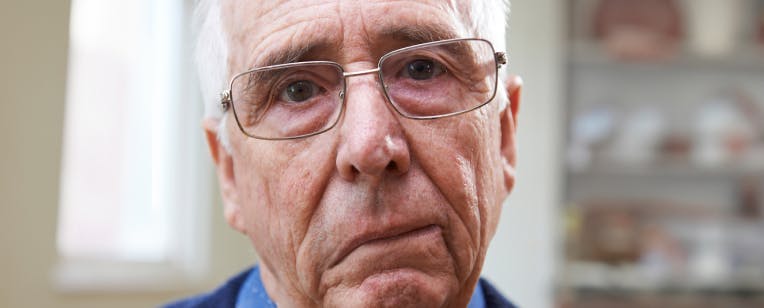You are about to leave a GSK website
You are about to leave a GSK website. By clicking this link, you will be taken to a website that is independent from GSK. The site you are linking to is not controlled or endorsed by GSK and GSK is not responsible for its content.
Shingles can lead to potential complications that can be serious and long-lasting1-3
Explore the different complications

Postherpetic neuralgia (PHN)
- PHN is a chronic, often debilitating condition that lasts for months (≥90 days) or even years after the shingles rash resolves1
- The risk of PHN increases with age; PHN occurs in 10% to 18% of patients with shingles1
- The nature of PHN pain can vary from mild to excruciating in severity, and can be constant, intermittent, or triggered by trivial stimuli1
- Among patients with shingles, certain comorbidities such as diabetes, COPD, and asthma have been associated with greater odds of developing PHN4

Herpes zoster ophthalmicus (HZO)
- HZO can lead to ocular complications and, in rare cases, vision loss1
- HZO occurs in 10% to 25% of patients with shingles1
- In a study, moderate vision loss (≤20/50) secondary to HZO occurred in 9.6% of patients while severe vision loss (≤20/200) occurred in 3.6% of patients5,*
- Causes of vision loss included corneal scarring (94%), corneal perforation (4.8%), and secondary glaucoma (1.2%)5,*
- Uveitis was the strongest risk factor for loss of vision6,*
- *
Data from a retrospective cohort study assessing the clinical presentation of HZO. A total of 869 patients with acute HZO seen at a single center from 2006 to 2016 were included in the analysis (age range from 1.3 to 100.2 years; median age at presentation 65.5 years). Among patients in this study, ~10% were immunocompromised. All outcomes were determined by direct chart review. Moderate vision loss was defined as best-corrected visual acuity of ≤20/50 and severe vision loss was vision ≤20/200.5

Cutaneous complications
- Cutaneous complications such as cellulitis, can result from shingles2
- Cutaneous complications have been observed in 2.3% of patients with shingles2,†,‡
- Bacterial superinfection of the lesions is typically due to Staphylococcus aureus and less often due to group A beta-hemolytic streptococcus6
- †
Data from a US retrospective cohort study assessing commercial health insurance claims in immunocompetent adults ≥50 years with a diagnosis of shingles (N=236,180) from 2008 to 2013.2
- ‡
Cutaneous complications included cellulitis and zoster gangrenosum.2

Neurologic
- While rare, shingles can lead to neurologic complications such as facial palsy, hearing loss, and encephalitis2
- Certain neurologic complications have been observed in 0.5% of patients with shingles2,§,||
- §
Data from a US retrospective cohort study assessing commercial health insurance claims in immunocompetent adults ≥50 years with a diagnosis of shingles (N=236,180) from 2008-2013.2
- ||
Neurologic complications included aseptic meningitis, cranial nerve palsies, deafness, diaphragmatic paralysis, encephalitis, motor neuropathy, sensory loss, transverse myelitis, Guillain-Barré syndrome, hemiparesis, Bell’s palsy.2

Stroke
- Shingles has been associated with a short-term increased risk of stroke. In a population-based study, 0.7% of patients had a stroke within 3 months post-shingles episode compared to 0.4% of people who did not have shingles3,¶
- The odds of stroke were 53% higher among patients with shingles than among patients who did not have shingles [OR 1.53 (95% CI: 1.01-2.33)]3,¶
- ¶
Data from a population-based community cohort study (January 1986 to October 2011) in adult residents of Olmsted County, Minnesota, 50 years and older; this retrospective study compared rates of post-HZ stroke with a cohort of age and sex-matched individuals. Risk was adjusted for several known risk factors and confounding factors for stroke. Among the patients with HZ (n=4478), 0.7% had a stroke within 3 months post-HZ compared to 0.4% in the non-HZ cohort (n=16,800).3
"I never thought shingles [PHN] would last this long, and the devastating effect that shingles could have on your body is unimaginable."
-Charles, age 65
Real person who experienced PHN, a long-lasting complication of shingles.
Other people's experiences may be different.

Charles, age 65
The pain during a shingles episode can impact your patients in multiple ways.7
More rash reality stories
Discuss shingles and its potential complications with your appropriate patients - see how you and your staff can get the conversation started.
References
- Harpaz R, Ortega-Sanchez IR, Seward JF; Advisory Committee on Immunization Practices (ACIP) Centers for Disease Control and Prevention (CDC). Prevention of herpes zoster: recommendations of the Advisory Committee on Immunization Practices (ACIP). MMWR Recomm Rep. 2008;57(RR-5):1-30.
- Meyers JL, Candrilli SD, Rausch DA, Yan S, Patterson BJ, Levin MJ. Costs of herpes zoster complications in older adults: a cohort study of US claims database. Vaccine. 2019;37(9):1235-1244.
- Yawn BP, Wollan PC, Nagel MA, Gilden D. Risk of stroke and myocardial infarction after herpes zoster in older adults in a US community population. Mayo Clin Proc. 2016;91(1):33-44.
- Forbes HJ, Bhaskaran K, Thomas SL, et al. Quantification of risk factors for postherpetic neuralgia in herpes zoster patients: a cohort study. Neurology. 2016;87:94-102.
- Niederer RL, Meyer JJ, Liu K, Danesh-Meyer HV. Herpes zoster ophthalmicus clinical presentation and risk factors for loss of vision. Am J Ophthalmol. 2021;226:83-89.
- About shingles (herpes zoster). Centers for Disease Control and Prevention. Reviewed January 17, 2025. Accessed January 31, 2025. https://www.cdc.gov/shingles/hcp/clinical-signs/index.html
- Curran D, Matthews S, Boutry C, Lecrenier N, Cunningham AL, Schmader K. Natural history of herpes zoster in the placebo groups of three randomized phase III clinical trials. Infect Dis Ther. 2022;11(6):2265-2277.
